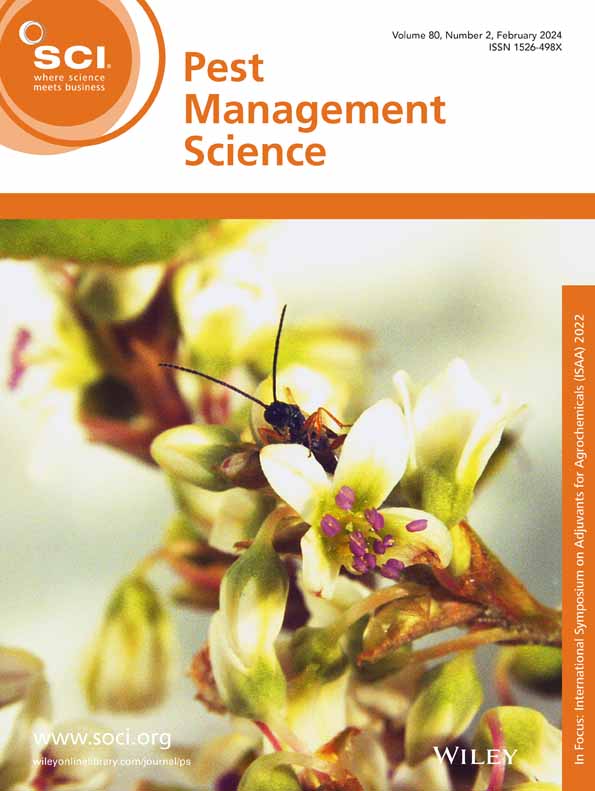Hashim Ibrahim, Vaderament-A. Nchiozem-Ngnitedem, Louise-Marie Dandurand, Inna Popova
下载PDF
{"title":"源自植物的天然杀线虫剂:二十年的新型化学成分。","authors":"Hashim Ibrahim, Vaderament-A. Nchiozem-Ngnitedem, Louise-Marie Dandurand, Inna Popova","doi":"10.1002/ps.8504","DOIUrl":null,"url":null,"abstract":"<p>Plant-parasitic nematodes are among the most destructive plant pathogens, resulting in a global annual economic loss of about 358 billion dollars. Using synthetic nematicides to control plant-parasitic nematodes has resulted in broad-spectrum toxicity to the environment. Plant-derived secondary metabolites have recently emerged as viable options that provide effective, greener, and renewable routes for managing plant-parasitic nematodes in various cropping systems. However, limited comprehensive information on plant-derived secondary metabolites sources, chemical structures, and nematicidal activities is available. This study aims to compile and analyze data on plant-based secondary metabolites with nematicidal properties collected over the last two decades. In this review, we identified 262 plant-based metabolites with nematicidal activities that were isolated from 35 plant families and 65 plant species. Alkaloids, terpenoids, saponins, flavonoids, coumarins, thiophenes, and annonaceous acetogenins were among the most studied compounds. In addition to the structure–activity relation for specific metabolites with nematicidal potency, various techniques for their extraction and isolation from plant material are discussed. Our findings demonstrate the potential of plants as a feedstock for sourcing nematicidal compounds and discovering new chemistries that could potentially be used for developing the next generation of nematicides. © 2024 The Author(s). <i>Pest Management Science</i> published by John Wiley & Sons Ltd on behalf of Society of Chemical Industry.</p>","PeriodicalId":218,"journal":{"name":"Pest Management Science","volume":"81 2","pages":"540-571"},"PeriodicalIF":3.8000,"publicationDate":"2024-11-06","publicationTypes":"Journal Article","fieldsOfStudy":null,"isOpenAccess":false,"openAccessPdf":"https://www.ncbi.nlm.nih.gov/pmc/articles/PMC11716366/pdf/","citationCount":"0","resultStr":"{\"title\":\"Naturally-occurring nematicides of plant origin: two decades of novel chemistries\",\"authors\":\"Hashim Ibrahim, Vaderament-A. Nchiozem-Ngnitedem, Louise-Marie Dandurand, Inna Popova\",\"doi\":\"10.1002/ps.8504\",\"DOIUrl\":null,\"url\":null,\"abstract\":\"<p>Plant-parasitic nematodes are among the most destructive plant pathogens, resulting in a global annual economic loss of about 358 billion dollars. Using synthetic nematicides to control plant-parasitic nematodes has resulted in broad-spectrum toxicity to the environment. Plant-derived secondary metabolites have recently emerged as viable options that provide effective, greener, and renewable routes for managing plant-parasitic nematodes in various cropping systems. However, limited comprehensive information on plant-derived secondary metabolites sources, chemical structures, and nematicidal activities is available. This study aims to compile and analyze data on plant-based secondary metabolites with nematicidal properties collected over the last two decades. In this review, we identified 262 plant-based metabolites with nematicidal activities that were isolated from 35 plant families and 65 plant species. Alkaloids, terpenoids, saponins, flavonoids, coumarins, thiophenes, and annonaceous acetogenins were among the most studied compounds. In addition to the structure–activity relation for specific metabolites with nematicidal potency, various techniques for their extraction and isolation from plant material are discussed. Our findings demonstrate the potential of plants as a feedstock for sourcing nematicidal compounds and discovering new chemistries that could potentially be used for developing the next generation of nematicides. © 2024 The Author(s). <i>Pest Management Science</i> published by John Wiley & Sons Ltd on behalf of Society of Chemical Industry.</p>\",\"PeriodicalId\":218,\"journal\":{\"name\":\"Pest Management Science\",\"volume\":\"81 2\",\"pages\":\"540-571\"},\"PeriodicalIF\":3.8000,\"publicationDate\":\"2024-11-06\",\"publicationTypes\":\"Journal Article\",\"fieldsOfStudy\":null,\"isOpenAccess\":false,\"openAccessPdf\":\"https://www.ncbi.nlm.nih.gov/pmc/articles/PMC11716366/pdf/\",\"citationCount\":\"0\",\"resultStr\":null,\"platform\":\"Semanticscholar\",\"paperid\":null,\"PeriodicalName\":\"Pest Management Science\",\"FirstCategoryId\":\"97\",\"ListUrlMain\":\"https://onlinelibrary.wiley.com/doi/10.1002/ps.8504\",\"RegionNum\":1,\"RegionCategory\":\"农林科学\",\"ArticlePicture\":[],\"TitleCN\":null,\"AbstractTextCN\":null,\"PMCID\":null,\"EPubDate\":\"\",\"PubModel\":\"\",\"JCR\":\"Q1\",\"JCRName\":\"AGRONOMY\",\"Score\":null,\"Total\":0}","platform":"Semanticscholar","paperid":null,"PeriodicalName":"Pest Management Science","FirstCategoryId":"97","ListUrlMain":"https://onlinelibrary.wiley.com/doi/10.1002/ps.8504","RegionNum":1,"RegionCategory":"农林科学","ArticlePicture":[],"TitleCN":null,"AbstractTextCN":null,"PMCID":null,"EPubDate":"","PubModel":"","JCR":"Q1","JCRName":"AGRONOMY","Score":null,"Total":0}
引用次数: 0
引用
批量引用


 求助内容:
求助内容: 应助结果提醒方式:
应助结果提醒方式:


